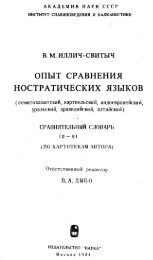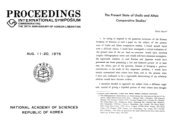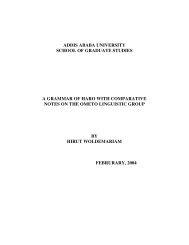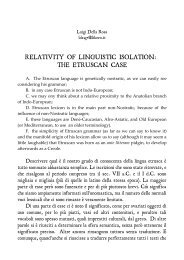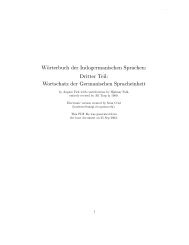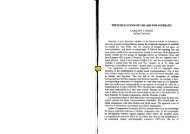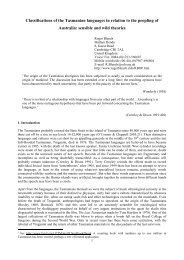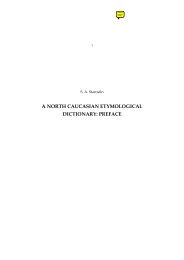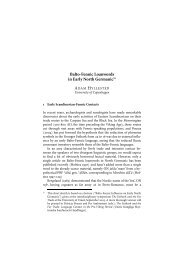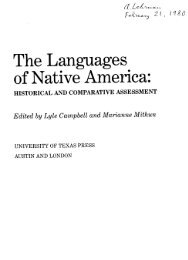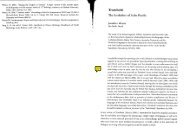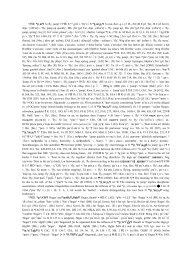The Indo-European Elements in Hurrian
The Indo-European Elements in Hurrian
The Indo-European Elements in Hurrian
Create successful ePaper yourself
Turn your PDF publications into a flip-book with our unique Google optimized e-Paper software.
20 2. Phonology, Writ<strong>in</strong>g Systems, Texts<br />
<strong>The</strong> two documents analyzed by Laroche display the same disposition: the cuneiform<br />
tablet on the left and the transliteration of the alphabet on the right. And next, a vocalization of<br />
the letters accord<strong>in</strong>g to a half-phonetic half-conventional system on the left and the translation<br />
<strong>in</strong>to French on the right. An extensive set of annotations follows and provides explanations. We<br />
have kept the general disposition. Laroche’s transliteration is updated accord<strong>in</strong>g to the order of<br />
the alphabet described above, and the reconstructed phonetics is strictly phonetic and does not<br />
<strong>in</strong>clude any cuneiformic conventions. In general, words or syntagms are separated by a vertical<br />
l<strong>in</strong>e (written here as ). Laroche has added blanks to separate words, but these blanks do not<br />
exist <strong>in</strong> the orig<strong>in</strong>al tablet.<br />
RS 24.261 <strong>in</strong> Laroche (1968:499—504) “Sacrifice to Astarte-Šauška”:<br />
<strong>The</strong> recto of the tablet is <strong>in</strong> very good shape. Most of it can be read fairly easily, and the<br />
miss<strong>in</strong>g letters can securely be <strong>in</strong>ferred. <strong>The</strong> verso is <strong>in</strong> bad shape and fragmentary. <strong>The</strong> tablet<br />
describes how a ceremony was held. As <strong>in</strong> Anatolian or Hittite rites, there were two times: first<br />
<strong>in</strong> the yard before the temple and then <strong>in</strong>side the temple. <strong>The</strong> first two l<strong>in</strong>es are <strong>in</strong> Semitic, then<br />
the rest is <strong>in</strong> <strong>Hurrian</strong>. One l<strong>in</strong>e (#9) is not understood.<br />
1. [db : «ttrt] (Semitic) Sacrifice to Astarte<br />
2. [qr9t 24 : bgrn] (Semitic) Invocation (?) <strong>in</strong> the yard<br />
3. [9t¯lm : t†tkd 25 ] *[asxuluma 26 sauskada] Sacrifice to Šauška 27<br />
4. [9gndym : tdndy] *[agandijama 28 sadandija 29 ] <strong>in</strong> the agandi and the sadandi 30<br />
5. [Õnmty : Õn¯zzy] *[<strong>in</strong>umasija 31 <strong>in</strong>ixadzidzija 32 ] <strong>in</strong> the place 33 and wisdom 34 of god(s)<br />
6. [kzġd 35 : Õn¯mnd] *[kudzuγada <strong>in</strong>xumun 36 da] to Kušu¯, to the god Hmn 37 ,<br />
7. [nntd kltd] 38 *[n<strong>in</strong>atada kulitada] to N<strong>in</strong>atta, to Kulitta,<br />
8. [nbdgd : wlbbtm] *[nubadigada, wali 39 bibita 40 dama] to Nubadig and the sacred house, 41<br />
24<br />
<strong>The</strong> mean<strong>in</strong>g of is <strong>in</strong>ferred. This looks like a derivative of Semitic qr" (cf. Arabic qara"a ‘to recite, to<br />
read; to study’) (Laroche 1968:501).<br />
25<br />
Note that the directive is used for the dative.<br />
26<br />
Cf. aš¯ušikunni ‘sacrificator’, aš¯u ‘high’; aš¯ul- ‘to raise’; aš¯ulumma ‘elevation’ (Laroche 1968:501).<br />
27<br />
This translates l<strong>in</strong>e #1 and establishes an equivalence Astarte = Šauška.<br />
28<br />
Attested partially as . -ma is an enclitic morpheme ‘and, then’.<br />
29<br />
<strong>in</strong> Cuneiform writ<strong>in</strong>g. Laroche provides no explicit equivalence for this word.<br />
30<br />
Laroche <strong>in</strong>terprets these two words as be<strong>in</strong>g nouns. It is worth wonder<strong>in</strong>g whether they should not be better<br />
<strong>in</strong>terpreted as be<strong>in</strong>g verbs <strong>in</strong> the Optative: ‘May she lead and well-feed us <strong>in</strong>to the k<strong>in</strong>gdom and wisdom of gods.’<br />
Moreover, this verbal <strong>in</strong>terpretation solves the problem of hav<strong>in</strong>g Datives marked with the Allative case-marker -da,<br />
a problem that Laroche himself had noticed.<br />
31<br />
<strong>in</strong> Cuneiform writ<strong>in</strong>g. This seems to mean the ‘place devoted to the god(s)’.<br />
32<br />
This word means ‘div<strong>in</strong>e wisdom , god of wisdom’ . <strong>The</strong> Semitic form is (cf.<br />
Akkadian ¯assu ‘<strong>in</strong>telligent, wise’, ¯asāsu ‘to heed a deity, to be pious; to be <strong>in</strong>telligent, understand<strong>in</strong>g; to<br />
remember; etc.’).<br />
33<br />
Laroche writes .<br />
34<br />
Laroche writes .<br />
35<br />
Instead of [k š ġ], which also exists.<br />
36<br />
Laroche (1968:530) suggests a read<strong>in</strong>g *[xumun] (?) for this word.<br />
37<br />
Possibly the thunderstorm god Àamani, equivalent to Tešub or, more probably, Àamu, the brother of Teššub.<br />
38<br />
<strong>The</strong>re is no vertical l<strong>in</strong>e <strong>in</strong> the tablet.



